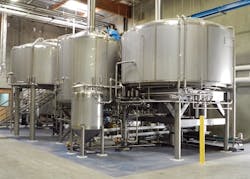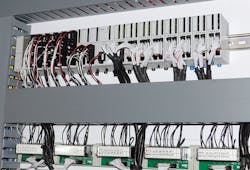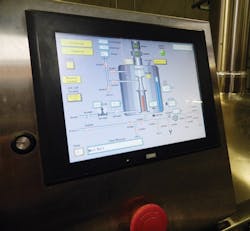Until recently, the 10-year-old microbrewer operated in a 4000-square-foot plant, and produced just 20,000 barrels (bbls) per year of its 20 brands, including its award-winning IPA Pale Ale. However, demand grew so fast that Green Flash's small facility couldn't keep up with demand. So it began working with Coastal Electric Co., a San Diego-based contractor, process engineer and system integrator, to design and build a new plant.
Automating the Artisan
Efforts to build Green Flash's new brew house began in summer 2010, and it took about nine months to design and construct. The new 45,000-square-foot plant was up and running at the end of last June.
"In the microbrewing industry, we usually find a shell of a building and then add brewing equipment to it, so that's what we did with this project. Next, we did the process engineering, P&IDs, piping design, and installed all the new equipment," says Keith Brushett, Coastal's president. "Demand for Green Flash's beer was super high, and they just couldn't make it fast enough. So the new facility was designed to produce about 100,000 bbls per year. But the only way to accommodate this capacity was to turn around the five vessels in the initial production process as fast as possible, and this required better automation." (Figure 1)
Figure 1: Green Flash Brewing uses a five-vessel initial production process, which is automated by Idec's micro PLC, and can turn around a typical 50-barrel batch in just three hours.
To automate Green Flash's new brew house, Coastal and Green Flash decided to implement Idec Corp.'s (www.idec.com) new Pentra FC5A-D12X1E micro PLC, which can perform the functions of larger PLCs at one-third the usual cost. "We'd used Idec's PLCs in several smaller projects, but this was the first time we used them to run an entire brewhouse," adds Brushett. "We counted all the inputs and outputs needed in the brew house and balanced them against the Pentra micro PLC's capabilities. It now has a faster microprocessor and faster I/O capability, so it was big enough to handle our job."
Consequently, while other brewing processes take five or six hours, Green Flash's brewmaster, Chuck Silva, and his staff can run a typical 50-bbl batch through their five vessels in just three hours. These vessels include a grist bin and malt handler, mash mixer, lauter tun unit for liquid separation, kettle for boiling the wort, and a whirlpool unit that processes the beer before it's sent to the fermenter. After this initial production process is complete, the beer goes to the fermenting facility for up to three weeks.
"Older brewing plants use a lot more space and much bigger vessels. They run a lot slower, use more power and cost more to operate and produce big, hoppy beers," says Brushett. "This new brew house has a lean, mean, turbocharged process. The brewmaster sets the benchmark, and our automation makes sure each batch is identical and maintains the brewer's touch."
Controlling the Craft
Inside the brew house's five-vessel process, Pentra micro PLC manages 37 analog inputs and seven analog outputs, 176 digital inputs and 186 digital outputs, and 11 Hitachi variable frequency drives (VFDs) via Modbus RS-485 communications (Figure 2). Also, Idec's TCP/IP protocol and Ethernet cabling is further used to link the plant's HG4G touchscreen (Figure 3) with the central control room's PCs for upper-level SCADA operations and web-based troubleshooting.
Figure 2: Idec's Pentra micro PLC and related process control and networking modules collect and manage data from the brew house's 37 analog inputs and seven analog outputs, 176 digital inputs and 186 digital outputs, and 11 Hitachi variable frequency drives (VFDs) via Modbus RS-485.
"We talk to the micro PLC with a Visual Basic program that extracts data points, puts them in an SQL server database and generates trending charts for yield, temperature fluctuations and other parameters. This allows Green Flash to archive a profile for each batch, track flavor performance in summer, for example, and make adjustments to optimize that performance," explains Brushett.
"Previously, we would have had to use a larger PLC that would have cost $30,000 to $35,000. But the process controls and other equipment we were able to install at Green Flash only cost about $10,000. And we also have web browsers built into the brew house's touchscreen controllers, so we didn't need to buy additional SCADA software, which saved about another $25,000," adds Brushett. Besides being less costly, Idec's controls also fit in an 8 x 10-foot cabinet, while equivalent, traditional PLCs would have required an 8 x 16-foot cabinet, according to Brushett.
Figure 3: A 12-inch HG4G touchscreen in Green Flash's brew house displays activity in one of its five vessels, which generate data via numerous analog and digital inputs and outputs that are managed by the micro PLC.
For now, the new micro PLC-controlled brew house can produce 400 bbls in 24 hours, which it's doing four days per week. "Presently, Green Flash is only limited by its fermenting capacity," adds Brushett. "The brewery presently has 14 fermenters, but it's in the process of building 10 more. And when Green Flash outgrows this new plant, they can just build another identical one."









